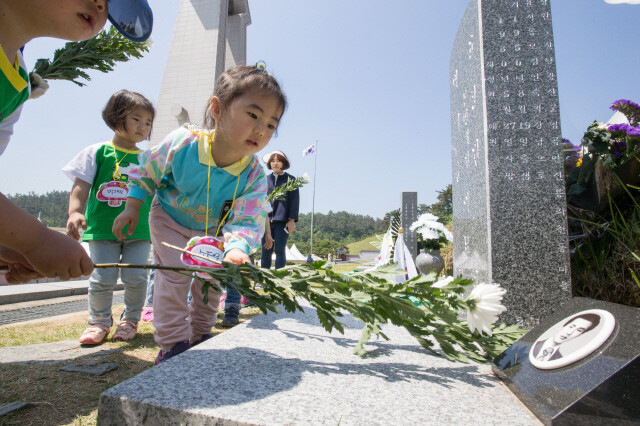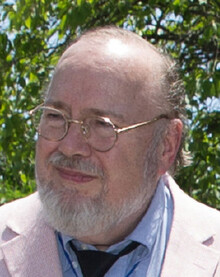hankyoreh
Links to other country sites 다른 나라 사이트 링크
Gwangju anniversary: the final interview of a martyr for democracy

On the night of May 26, 1980 - the night before the South Korean army marched into Gwangju to enforce martial law - Bradley Martin, at the time a reporter for the Baltimore Sun, conducted his last interview with Yun Sang-won (1950-1980), spokesperson for the Gwangju citizen army. Bradley said of Yun, “He didn’t run away, and he died knowing full well that resistance meant death.”
Martin is back in South Korea this week for the anniversary of the Gwangju Democratization Movement, and was interviewed by a Hankyoreh reporter on the evening of May 16.
“He looked me in the eyes, and he chose me for the interview. It was like he was giving me his last will. His determination to die has stuck with me,” Martin said.
“I already had a feeling that he [Yun Sang-won] was going to die. He seemed to know that, too. There was gentleness and kindness on his face, but I could also sense the shadow of death that was coming closer each second. I remember the intellectual shape of his eyes and his prominent cheekbones as he promised they would fight to the end,” Martin wrote in an article that ran in the monthly magazine “Water from a Deep Spring” in 1994.

Just as Yun promised in the interview, he fought until the bitter end of the Gwangju Uprising and lost his life in the early morning hours of May 27, 1980.
Yun was the person who inspired the composition of the song “March for the Beloved,” which has recently been at the center of a controversy about whether the song will be sung in unison at the memorial ceremony for the Gwangju Uprising.
The song was written in Apr. 1982, two months after Yun’s “spiritual wedding” to Park Gi-sun (1957-1978), a labor activist and student at the history education department at Chonnam National University.
Citing the phrase “symbolic suicide” that appears in an article Martin wrote in 2000, some have claimed that Yun blew himself up with a grenade. “Bullshit,” replied Martin, who said this was a complete distortion of the facts.
“I was emphasizing the fact that Yun was prepared to die even though he knew that the military was coming [the next day],” Martin said, explaining what the phrase really meant. He also promised to write a response to articles that misrepresent Yun’s death when he returns to the US.
The radical right wing in South Korea misrepresents the Gwangju Uprising and attempts to portray Yun’s death as a suicide because Yun, in Martin‘s words, is “a symbolic figure in the Gwangju Uprising who led the final resistance in May 1980.”
“They’re trying to undermine the spirit of the Gwangju Uprising, its legitimacy and the sacrifices made,” Martin said.
Some on the far right mention an article that says that “next to Yun’s body, a curtain that had melted in the fire had turned as hard as ashes” as evidence of his suicide. They even make the absurd claim that 13 of the 15 members of the citizen army who were shot by the South Korean army in the former office of South Jeolla Province government (where the citizen army made its last stand in the early morning hours of May 27, 1980) were killed when Yun blew himself up with a grenade.
During a meeting with former members of the citizen army on May 16, Norman Thorpe, a former reporter for the Asian Wall Street Journal, said that claims about Yun’s suicide were “completely fabricated.”
Thorpe was the first foreign correspondent to photograph Yun‘s corpse in the second floor reception room of the old South Jeolla Provincial Office.
When asked whether he had thought that Yun’s death was a suicide, Thorpe said, “I didn’t think so at all. If he had killed himself, what would he have used to light the fire? Also, the area around him would have been in disarray because of the pain of burning. But if you look at the picture I took, his body is in a neat line, and there is a neat pile of ashes, too. Clearly, he died for some other reason, and the fire was presumably lit afterward.”
The official cause of Yun’s death as reported in a surviving autopsy record is “burns and stab wounds.”
“It’s possible that, after Yun was shot dead and he lay under a blanket, the soldiers doused him with flammable materials and then set the blanket on fire. After it burned, they may have stabbed Yun with a bayonet to make sure he was dead,” said a researcher who has studied the events of the Gwangju Uprising.
By Jung Dae-ha, Gwangju correspondent
Please direct questions or comments to [english@hani.co.kr]

Editorial・opinion
![[Column] Is Korean democracy really regressing? [Column] Is Korean democracy really regressing?](https://flexible.img.hani.co.kr/flexible/normal/500/300/imgdb/original/2024/0705/2917201664129137.jpg) [Column] Is Korean democracy really regressing?
[Column] Is Korean democracy really regressing?![[Column] How tragedy pervades weak links in Korean labor [Column] How tragedy pervades weak links in Korean labor](https://flexible.img.hani.co.kr/flexible/normal/500/300/imgdb/original/2024/0703/8717199957128458.jpg) [Column] How tragedy pervades weak links in Korean labor
[Column] How tragedy pervades weak links in Korean labor- [Column] How opposing war became a far-right policy
- [Editorial] Korea needs to adjust diplomatic course in preparation for a Trump comeback
- [Editorial] Silence won’t save Yoon
- [Column] The miscalculations that started the Korean War mustn’t be repeated
- [Correspondent’s column] China-Europe relations tested once more by EV war
- [Correspondent’s column] Who really created the new ‘axis of evil’?
- [Editorial] Exploiting foreign domestic workers won’t solve Korea’s birth rate problem
- [Column] Kim and Putin’s new world order
Most viewed articles
- 110 days of torture: Korean mental patient’s restraints only removed after death
- 2Former bodyguard’s dark tale of marriage to Samsung royalty
- 3Koreans are getting taller, but half of Korean men are now considered obese
- 4Real-life heroes of “A Taxi Driver” pass away without having reunited
- 5Foreign day laborers make up majority of death toll in Korean battery factory fire
- 6Months after outcry over “torture devices,” Justice Ministry proposes more restraints for immigratio
- 7[Column] Is Korean democracy really regressing?
- 8[Editorial] Exploiting foreign domestic workers won’t solve Korea’s birth rate problem
- 9[Column] How tragedy pervades weak links in Korean labor
- 10Car behind deadly crash began rapid acceleration after exiting underground garage